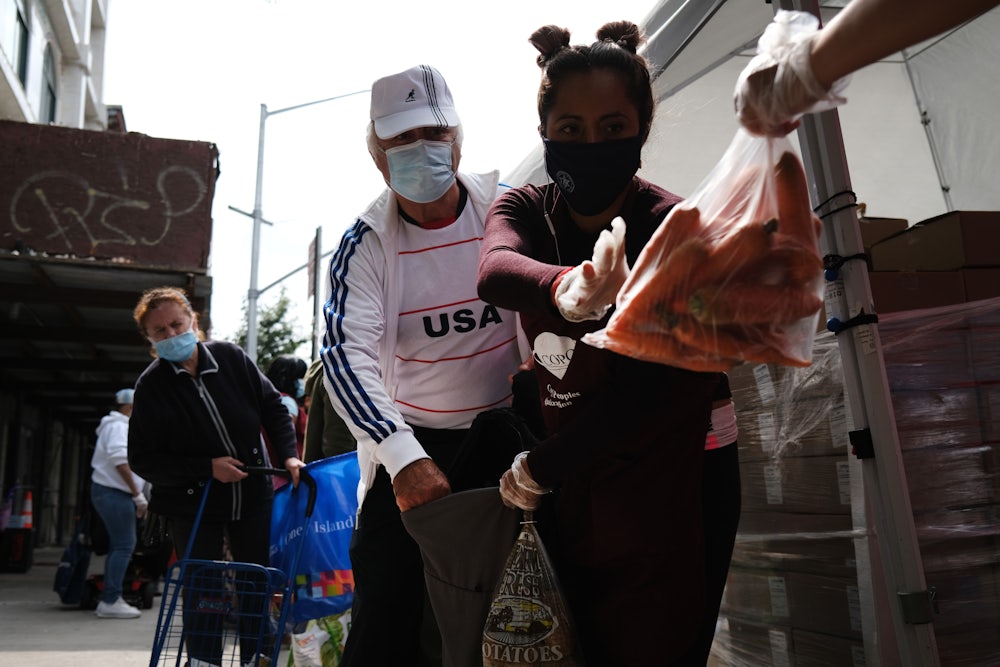We now have new numbers to confirm what everyone who received a $1,200 stimulus check or extra unemployment benefits over the summer likely already knows: Additional government money is a good thing during an economic collapse. As The New York Times reported this week, two recent studies have found that over the last few months, between six to eight million additional people officially fell below the poverty line, in the absence of renewed government aid, after several provisions in the Cares Act expired in July.
This, of course, suggests that the first stimulus worked largely as intended: As poverty researcher H. Luke Shaefer told the Times, “It wasn’t perfect, but hands down it’s the most successful thing we’ve ever done in negating hardship.” In July, for instance, 70 percent of people surveyed by the Fed said they could cover a $400 emergency expense, which was higher than the number of people who said the same even prior to the pandemic.
But it’s also the case that the official poverty numbers alone have never fully captured the scope of economic strain in this country, and that millions of people in the United States hover just above the poverty line or continually drift back and forth across it. (The official label for the group that doesn’t quite make the poverty cutoff is “near poor,” a distinction that I suspect is little comfort to those who might be able to pay their utility bills one month but know they won’t the next.) The weekly $600 unemployment supplement and no-strings checks supplied by the Cares Act didn’t just pull back people from the brink of disaster but also demonstrated that there’s little other than political inertia that keeps the government from providing every person with the resources needed not just to clear the low bar of the poverty line but to live a decent and dignified life.
Most of our existing measurements of poverty also raise the question of low expectation when it comes to how people live and what they deserve. If the highest aspiration of our present policy regime is to lift people out of poverty, as the refrain often goes, what kind of life does that guarantee? Shouldn’t we reach for more than whatever rests just above abject misery?
Researchers have previously criticized the way the poverty rate is calculated, which is based on a theoretical household budget from more than half a century ago that fails to take into account a number of safety-net programs (and also presumes that every household comes with a housewife who, as the late economist Molly Orshansky put it, “will be a careful shopper, a skillful cook, and a good manager who will prepare all the family’s meals at home”).
For a more accurate gauge of poverty, some economists have advocated using the Supplemental Poverty Measure, which includes benefits like food stamps when measuring income, and therefore better reveals the extent to which such programs help people—or, conversely, how dire things become when such benefits are slashed or shuttered. Yet even this expanded definition has its shortcomings; as Center for Economic Policy and Research fellow Shawn Fremstad recently wrote, under this measure, “two adults raising two children in 2019 needed only $28,881 to not be poor (assuming they rented and lived somewhere with average housing costs).” For context, the average cost of a full-time childcare program was $16,000 that year.
The poverty rate, in other words, is only one of many stark reminders of how difficult it is to make ends meet in an economy that’s set up to deliver spoils to the top at the expense of everyone else. Today, the bottom 50 percent of the country owns almost no wealth, and one estimate last year found that a staggering four out of five Americans, or around 78 percent, were living paycheck to paycheck. While not everyone in that group is technically living in poverty, their distance to that line is perhaps shorter than official poverty measures can capture.
And yet there’s a political contingent that astonishingly still seems to find any assessment of scarcity gratuitous. “I’m not as alarmed about poverty as I am about unemployment,” conservative policy adviser Jason Turner told the Times on Thursday. “Poverty is an arbitrary income threshold, and people who dip below it, they make adjustments.” That’s a particularly cruel way to describe the kinds of serious trade-offs that people who don’t have enough money are forced to make.
From the Times:
Now living on $350 a week plus food stamps, Ms. Jeffcoat and her husband have gone without electricity because they cannot afford generator fuel (their house is off the power grid) and have spent weeks without propane for cooking and hot showers. “We stick with cold meals—cereals,” she said.
To feed the children, Ms. Jeffcoat said she sometimes skips meals, especially at the end of the month when the food stamps have run out. Her husband sold his tools to buy diapers, and Ms. Jeffcoat tried to sell her eggs to a fertility clinic, but she did not medically qualify. Worse than the physical hardships is the worry.
One person’s “arbitrary income threshold,” then, is another family’s profound distress. In the current void left by the eternal partisan tug-of-war (not to mention Donald Trump’s wild vacillations) over the fate of a new stimulus package, grasping the extent to which economic hardship has surpassed what the official numbers can demonstrate has taken on a new and unsettling urgency. No politician across the political spectrum would ever say that they don’t want to lower the official poverty rate; the point is that the pandemic shows that we’re also overdue to change the way we conceive of that poverty rate itself. Every person should be guaranteed a living, but more than that, every person should be guaranteed a good one.
